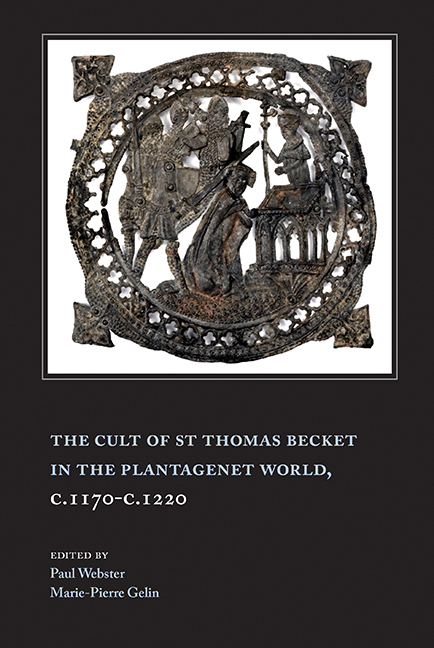Book contents
- Frontmatter
- Contents
- List of Illustrations
- List of Contributors
- Preface
- Acknowledgements
- List of Abbreviations
- 1 Introduction. The Cult of St Thomas Becket: An Historiographical Pilgrimage
- 2 Becket is Dead! Long Live St Thomas
- 3 The Cult of St Thomas in the Liturgy and Iconography of Christ Church, Canterbury
- 4 Thomas Becket and Leprosy in Normandy
- 5 Thomas Becket in the Chronicles
- 6 Matilda, Duchess of Saxony (1168–89) and the Cult of Thomas Becket: A Legacy of Appropriation
- 7 Leonor Plantagenet and the Cult of Thomas Becket in Castile
- 8 Crown Versus Church After Becket: King John, St Thomas and the Interdict
- 9 The St Thomas Becket Windows at Angers and Coutances: Devotion, Subversion and the Scottish Connection
- Bibliography
- Index
3 - The Cult of St Thomas in the Liturgy and Iconography of Christ Church, Canterbury
Published online by Cambridge University Press: 25 October 2017
- Frontmatter
- Contents
- List of Illustrations
- List of Contributors
- Preface
- Acknowledgements
- List of Abbreviations
- 1 Introduction. The Cult of St Thomas Becket: An Historiographical Pilgrimage
- 2 Becket is Dead! Long Live St Thomas
- 3 The Cult of St Thomas in the Liturgy and Iconography of Christ Church, Canterbury
- 4 Thomas Becket and Leprosy in Normandy
- 5 Thomas Becket in the Chronicles
- 6 Matilda, Duchess of Saxony (1168–89) and the Cult of Thomas Becket: A Legacy of Appropriation
- 7 Leonor Plantagenet and the Cult of Thomas Becket in Castile
- 8 Crown Versus Church After Becket: King John, St Thomas and the Interdict
- 9 The St Thomas Becket Windows at Angers and Coutances: Devotion, Subversion and the Scottish Connection
- Bibliography
- Index
Summary
On Christmas Day 1170, a few weeks after his return to England after seven years in exile in France, Archbishop Thomas Becket preached a sermon in his cathedral at Canterbury. While speaking of the men who had preceded him in the see, ‘the holy men who are [buried] here … he said that they had one martyr archbishop, St Alphege, and that it was possible that before long they would have another.’ A few days later, on 29 December, Thomas Becket was killed in the cathedral by four royal knights, not very far from the spot where he had preached on Christmas Day, and he indeed became the other martyr of Canterbury, as he had seemingly foreseen. The liturgy for his feast day further adds that at the point of death, he commended his soul to several saints, among them to ‘sanctis hujus ecclesiae patronis’, while one of his biographers specifies that he explicitly invoked St Alphege. Archbishop Thomas is thus presented as belonging to the long line of archbishops of Canterbury who displayed admiration and veneration for their sainted predecessors. Alphege (1006–12), for instance, was devoted to the memory of St Dunstan (959–88); Anselm (1093–1109) defended Alphege's claim to sanctity against the doubt expressed by Lanfranc (1070–89); Lanfranc himself turned to St Dunstan for help and support on several occasions. Thomas Becket himself, during his pontificate, sought to have Anselm formally canonised by the pope, although the quarrel with Henry II prevented him from seeing this task through.
From the point of view of the monastic community, Archbishop Thomas did not fit easily in the traditions of Christ Church. As a secular clerk, he had spent most of his career serving the Crown. Even after he became archbishop of Canterbury, his relations with the monastic community, whose nominal abbot he was, had been at best distant and at worst confrontational. The monks, however, rapidly and enthusiastically supported the beginnings of the cult of the new martyr. After the murderers had departed, they removed the body to the front of the main altar of the cathedral and carefully collected the blood which had been spilled. While preparing the archbishop's body for burial, they discovered that he had been wearing monastic garments under his archiepiscopal vestments, as well as a hair shirt next to his skin, revealing Becket'saustere habits of discipline.
- Type
- Chapter
- Information
- Publisher: Boydell & BrewerPrint publication year: 2016



